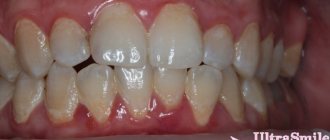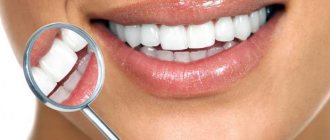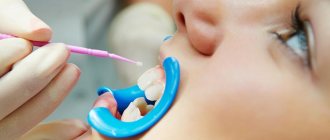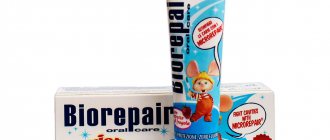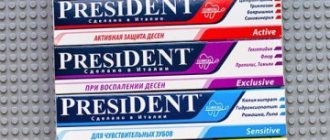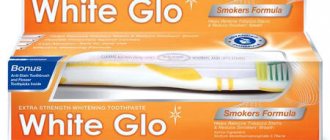Author of the article:
Soldatova Lyudmila Nikolaevna
Candidate of Medical Sciences, Professor of the Department of Clinical Dentistry of the St. Petersburg Medical and Social Institute, Chief Physician of the Alfa-Dent Dental Clinic, St. Petersburg
Snow-white, fragrant and soft toothpaste not only gives pleasant emotions in the morning and evening, but also helps your smile remain snow-white and healthy. But time passes, and every new day with its coffee and tobacco stress weakens the health of our teeth, and we have to think about more effective means of strengthening our smile. What to do if the enamel has become weaker? First, you need to choose the right toothpaste. Today we will talk about what product you need to choose to strengthen the enamel.
Why is fluoride in toothpaste harmful?
This element is one of the most toxic to humans. Its compounds - fluorides - lead to digestive system disorders, damage to the nervous and cardiovascular systems, etc. Of course, this requires large doses of such substances.
But even microscopic portions of fluoride, which modern toothpastes cannot do without, are enough to have a negative effect on the body.
This element is present in food and enters the body every day, and in some areas its compounds flow from the soil into drinking water. Therefore, adding fluoride from toothpaste to your diet every day is overkill. Instead of protecting against caries, it provokes the development of a disease such as fluorosis, that is, the destruction of enamel. First, whitish streaks and specks appear on it, then dark spots, then the enamel wears off, unevenly in certain areas. As a result, the shape of the teeth changes, they become fragile and can break.
Natural toothpaste with herbs Herbal Fresh&Cool, 100 gr, Twin Lotus
265 ₽
Dietary supplement NOT A MEDICINE
TO THE CATALOG - BUY TOOTHPASTE WITHOUT FLUORIDE
Why is tooth enamel destroyed?
Unfortunately, regular visits to the dentist do not guarantee the integrity of the enamel. As a rule, tooth surface destruction is provoked by a number of factors, the most common of which are:
- Mechanical damage to the crown - strong squeezing of the jaw, blows, opening lids and caps with teeth, gnawing on nuts and seeds.
- Temperature effects - alternating exposure to cold and hot temperatures provokes the appearance of cracks in the enamel.
- Caries, obvious or latent, is the main cause of enamel destruction.
Often weak enamel and bad teeth are inherited.
A common cause of enamel destruction is a lack of calcium in the body. Due to the small amount of this element, its demineralization occurs and its protective properties decrease. Various chronic diseases can also affect the condition of the oral cavity:
- gastritis (gastroduodenitis);
- hypertension;
- disruptions in the functioning of the endocrine system;
- dysfunction of the salivary glands;
- nervous disorders;
- pathological bite;
- bruxism;
Doctors include additional reasons for enamel destruction:
- poor nutrition;
- excessive alcohol consumption;
- smoking;
- breathing through the mouth.
Enamel suffers especially in women during pregnancy. This condition completely changes the body at the hormonal level, which inevitably affects the absorption of calcium and the strength of tooth enamel. The baby in the womb takes the necessary vitamins and microelements for itself, and if the mother does not have enough of them, the enamel will begin to deteriorate first.
What is the effect of titanium dioxide on the body?
For a long time it was believed and is still believed at the official level that this compound is absolutely inert and does not linger in the body. Therefore, under the name “additive E171”, it is generously added both to hygiene products and food products - yoghurts, marshmallows, crab sticks, etc.
But a study by Chinese scientists suggests that titanium dioxide particles penetrate from the gastrointestinal tract into other organs and damage the liver and kidneys. And scientists from the USA discovered that this substance has a negative effect on the cells of the brain and nervous system, causing their diseases.
Toothpaste “Herbal Twin Lotus Original”, with herbs, 100 g, Twin Lotus
265 ₽
Dietary supplement NOT A MEDICINE
Enzyme preparations
Enzyme preparations introduced into toothpastes have a fairly wide spectrum of action.
Enzymes dissolve the organic material of dental plaque without damaging living tissue, have a beneficial effect on periodontal tissue and the oral mucosa, utilize toxic and irritating waste products of dental plaque microorganisms, and have a direct or indirect bactericidal and bacteriostatic effect. Proteases, dextranases, carbohydrase, invertase, mutanase, oxireductase, lactate dehydrogenase, and amylglucosidase were used as components of toothpastes.
Enzymes that have antimicrobial and antiviral effects are also used - lysozyme, ribonuclease, deoxyribonuclease, peroxidase, glucose oxidase, lactoperoxidase.
Quite often, combinations of enzymes are used: carbohydrase, protease and lipase, dextranase, amylase and mutanase, dextranase, amylglucosidase, lactoperoxidase and lysozyme.
Enzyme-containing toothpastes include Biotene (contains glucose oxidase, lactoperoxidase, lysozyme, sodium monofluorophosphate and xylitol), Protodent (contains protease), First Teeth (contains lactoperoxidase and lactoferrin). They are indicated for significant formation of non-mineralized dental plaque, hyposalivation, increased viscosity of saliva, and dysbiosis of the oral cavity. Enzymes are labile compounds, so stabilizers are added to toothpastes (for example, for dextranase, these are gelatin, sodium or potassium chloride, sorbic acid, aluminum hydroxide, eugenol, sodium salicylate, acyl taurate, sorbitol, soluble salts of sulfuric acid).
What to use for oral care?
In order not to expose yourself to the risk of “eating” on dangerous substances, you should use natural toothpaste. These products do not sparkle with dazzling whiteness; they have natural yellowish and beige shades. If it includes herbs, it has a greenish color; if it contains coal, it is black.
Such hygiene products can protect against caries no worse than conventional toothpastes: they contain natural ingredients that destroy bacteria. These are sorbitol, borneol, clove oil, myrrh extract.
Natural salt toothpaste, 75 ml, Weleda
555 ₽
Dietary supplement NOT A MEDICINE
Mineral salts
Mineral salts and their complexes added to toothpastes have a beneficial effect on the oral mucosa, help improve blood circulation, dissolve mucus, and prevent the formation of soft plaque. Salts are able to maintain the acid-base balance, normalizing metabolic processes, alkalizing the oral cavity and, creating an optimal environment for enamel mineralization processes, stimulate salivation, thus ensuring the implementation of the protective and buffering functions of saliva. Some of the salt additives contain macro- and microelements that can be included in the hard tissues of the tooth. The high concentration of salts in pastes causes an increased outflow of tissue fluid from the inflamed gums, and also has some analgesic effect.
Toothpastes contain sea salt and table salt. Mineral waters rich in salts and brine from the Pomorie estuaries are used, which also improves the blood supply to periodontal tissues and their trophism. Sodium bicarbonate (baking soda) is a mild abrasive that neutralizes the acidic activity of bacteria.
Salt-containing toothpastes
indicated for significant formation or tendency to form non-mineralized dental plaque, chronic inflammatory diseases of the periodontium and oral mucosa, increased viscosity of saliva, hyposalivation.
Features of cleaning teeth with salt
Attention! You can use additional salt every day to clean your teeth. You can use any salt - table salt or sea salt. Seafood is considered healthier, but if it is not available, then regular one will do.
Some important tips for brushing your teeth with salt:
- The first few cleanings can be done without using a toothbrush. Cleaning can be done using your fingers and tongue;
- You can take about a teaspoon of salt into the oral cavity, then the salt should be gently rubbed on the surface of the teeth using the tongue and fingers;
- Once the salt crystals have dissolved, the salty saliva is rubbed into the gums at the base of the teeth;
- At the end of the procedure, the mouth should be rinsed with water;
- After complete adaptation, after about 3-4 procedures, cleansing should be done with a toothbrush;
- For cleaning, you should prepare a mixture of salt and water, which in consistency resembles a paste;
- The prepared salt mixture is applied to the surface of the toothbrush and the cleaning process begins. When cleaning, do not press the brush too hard, otherwise you may damage the tooth enamel;
- To improve the composition, you can add a little toothpaste to the salt mixture;
- Cleaning should be done with vertical movements so as not to damage the enamel;
- After complete cleansing, it is recommended to massage the gums.
Toothpaste made from salt and water strengthens teeth, prevents decay, removes bad breath, and heals gums. In addition, salt perfectly whitens enamel and eats away tartar.
How to cleanse with salt:
- To begin with, the toothbrush is moistened with water;
- Place the brush in the salt;
- After this, we proceed to cleansing. To begin with, movements are made with the brush in a vertical direction over the entire surface of the dentition;
- Next, you need to clean the inside of the dentition from plaque;
- Then we proceed to clean the outer surface.
Cleaning should be done correctly and carefully, otherwise you may cause harm to tooth enamel instead of benefit. If done correctly, your teeth will become white and strong.
Positive traits
Hygienic cleaning of dental units is a useful procedure that allows you to achieve strengthening and healing of weakened teeth. In addition, this procedure has a number of positive qualities:
- Has a positive effect on all tissues of the oral cavity;
- It is accessible and low cost compared to other whitening products;
- When ingested, it does not have a harmful effect, unlike other teeth cleaning products;
- Does not cause side effects;
- When used, it reduces unpleasant odor from the mouth;
- Reduces the risk of such unpleasant pathological processes as periodontal disease, periodontitis, and carious lesions;
- All stores always sell only natural table salt without various impurities
The main positive qualities that distinguish cleansing with salt from other methods are accessibility, because you can buy salt in any store, and harmlessness, because Getting salt into your body will not harm your health.
How to choose toothpaste
Let's return to the topic of the article. After all, since all pastes contain the same ingredients, how can you choose the right one for yourself? Let's introduce the main product segments.
Whitening
This is the most popular segment among oral care product choices. Many consumers are afraid to purchase such toothpastes due to fear of large amounts of abrasives. We hasten to reassure you, the composition of whitening pastes is not much more complicated than the ingredients of representatives of other segments.
Whitening toothpastes, of course, do not contain bleaches. They actually contain abrasives and chemical compounds that effectively polish the teeth and help fight stains on the surface of the teeth. But if you want truly effective whitening, the effect can only be achieved in a dental clinic using the Zoom3 teeth whitening procedure.
And, despite their gentle composition, whitening pastes cannot be used more than 2-3 times a week to avoid increased sensitivity of the enamel.
Toothpaste for sensitive teeth
This type of hygiene is designed to block dentinal tubules that can become open due to certain gum diseases and minimize sensitivity when brushing. Pastes that perform this function must be marked on the packaging with specialized information. The composition must include potassium salts (nitrate, chloride), they block the transmission of impulses, reducing tooth sensitivity. Also pay attention to the abrasiveness index (RDA), it should not exceed level 25.
But we want to warn you that this is not a cure and you should not experience increased tooth sensitivity for a long time, do not go to the dentist, counting on the help of toothpaste!
Protecting enamel, preventing the formation of tartar
Enamel is the outer covering of a tooth. Although it is much harder than inner dentin, it becomes thinner and damaged over time. There are a huge number of products aimed at protecting enamel. We asked Svetlana Nikolaevna which remedy is best suited and received the answer:
– Enamel is fluorine. And when you brush your teeth with fluoride toothpaste, it's like you're wearing armor. If you pay attention to the composition, you will see that fluoride is contained in almost everything. This means that each toothpaste protects your teeth enamel equally.
The same applies to stone. By brushing your teeth regularly and using the right brush, most toothpastes will help reduce plaque on your teeth. But this does not eliminate the need for regular visits to the dentist for professional hygiene.
The composition of products that protect against the formation of tartar must include calcium carbonate, which is an active abrasive substance and effectively cleans teeth.
Natural toothpaste
Today it has become fashionable to consume everything natural. Paying tribute to trends, manufacturers have brought to the market a fairly wide range of natural and herbal toothpastes. Please note that most of the products presented do not contain fluoride, which means they have absolutely no benefit for your teeth.
So, the main advice is to look for toothpaste that contains fluoride. And then choose by price. If you are still in doubt, we invite you to a free consultation at our dentistry. The doctor will check the condition of your oral cavity and help you choose dental care products. You can sign up online by clicking on the icon, or by phone in the header of the site.
About the author . Svetlana Nikolaevna Korneva, chief physician, dentist-therapist at the Diamed clinic. Experience since 1989. Specializes in providing therapeutic assistance of any degree of complexity. Graduated from Izhevsk State Medical Institute with honors in 1989. In 1990, she completed her internship in therapeutic dentistry. Active member of the Dental Association of Russia (StAR).
Sage
Another popular natural ingredient that has a wide range of health benefits. It has long been used by pharmacists around the world, using the leaves, as well as extracts and essential oil. Sage has anti-inflammatory, antiseptic, hemostatic, and astringent effects. Rinsing with sage decoction is often prescribed to patients after a tooth extraction procedure, as well as in cases where an antiseptic and healing effect is needed. Medicinal toothpaste
, which contains sage, is usually used to treat and prevent bleeding gums.
